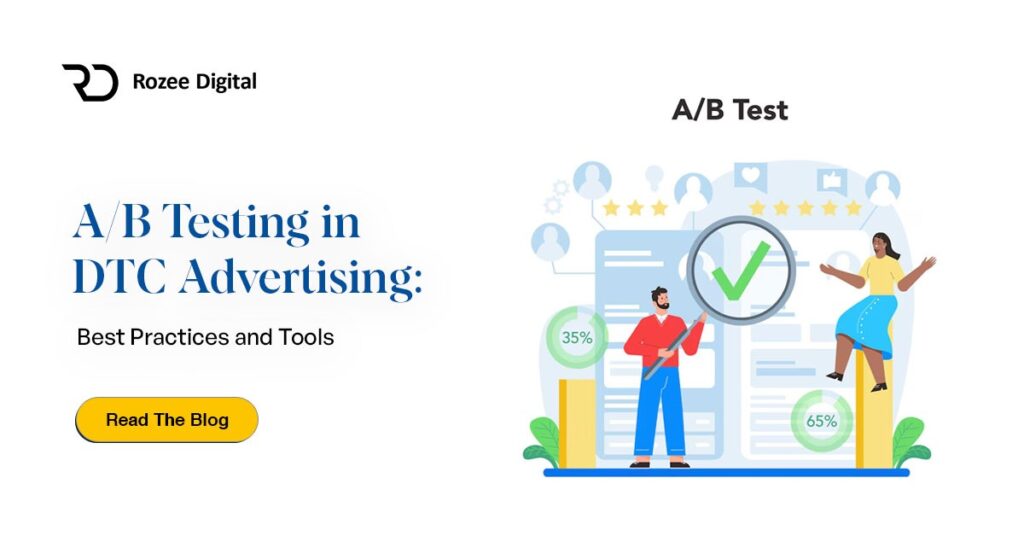Direct-to-Consumer (DTC) advertising has become a powerful strategy for brands looking to engage customers directly, bypassing intermediaries. One critical method for optimizing DTC advertising is A/B testing, a process that allows marketers to compare two versions of an ad, landing page, or email to see which performs better. In this post, we’ll explore the best practices and tools for effective A/B testing in DTC advertising to maximize conversion rates and improve customer engagement.
What is A/B Testing in DTC Advertising?
A/B testing, also known as split testing, involves creating two variations of an ad or webpage—Version A and Version B. These versions are shown to different segments of your audience to determine which performs better based on key performance metrics such as click-through rates (CTR), conversion rates, and return on ad spend (ROAS).
For DTC brands, A/B testing is vital in refining Personalization in DTC Ads, Personalized Marketing, and improving Customer Segmentation. Testing different elements like copy, images, or CTA buttons allows brands to identify what resonates most with their audience.
Best Practices for A/B Testing in DTC Advertising
- Set Clear Objectives Before launching an A/B test, identify what you’re trying to achieve. Are you looking to improve Personalized Ad Campaigns, increase customer engagement, or reduce cart abandonment? Establishing clear goals ensures that your testing efforts are focused and aligned with business objectives.
- Test One Variable at a Time To obtain reliable results, focus on testing one element at a time. Whether it’s the headline, CTA, or images, isolating variables ensures that you know exactly what caused the change in performance.
- Segment Your Audience DTC brands often rely on Customer Segmentation to tailor their messaging. When conducting A/B testing, make sure your test groups are segmented based on relevant factors like demographics, purchasing behavior, or location. This ensures your results are applicable to the specific audience you’re targeting.
- Leverage Behavioral Targeting Behavioral targeting is key in optimizing personalized campaigns. Use Behavioral Targeting data to test ads on audiences that are likely to engage based on past interactions with your brand. This helps improve relevancy and efficiency in your campaigns.
- Run Tests Long Enough One common mistake in A/B testing is stopping the test too soon. Ensure that your test runs for a sufficient time to gather a statistically significant sample size. If you stop the test too early, the results may be skewed or unreliable.
- Analyze Beyond CTR While CTR is an important metric, DTC brands need to look at deeper conversion metrics, such as average order value (AOV), customer lifetime value (CLV), and revenue per visitor. Focus on metrics that align with your long-term business goals rather than just short-term clicks.
- Use Data-Driven Personalization The results from your A/B tests should feed into Data-Driven Personalization strategies. For example, if certain types of content or imagery consistently perform better, integrate those insights into future Personalized Ad Campaigns and overall marketing strategies.
Top Tools for A/B Testing in DTC Advertising
To streamline A/B testing and maximize results, you can leverage several tools designed for DTC advertising. Here are some of the best tools to consider:
- Google Optimize Google Optimize is a free A/B testing tool that integrates seamlessly with Google Analytics. It allows you to test changes to your website and track the impact on conversions. This tool is especially useful for DTC brands focusing on retargeting strategies and optimizing website performance.
- Optimizely Optimizely is a leading experimentation platform that offers advanced testing features for websites, mobile apps, and even emails. Its robust reporting features allow you to segment users based on behavior, location, and other criteria, making it perfect for Personalized Customer Experiences.
- VWO (Visual Website Optimizer) VWO provides an intuitive platform for running A/B tests, split URL tests, and multivariate tests. It’s a go-to solution for brands looking to refine their Dynamic Content and personalized marketing strategies.
- Unbounce If you’re focusing on landing page optimization, Unbounce is an excellent tool for testing different variations of your pages. Its drag-and-drop builder makes it easy to create multiple versions of a landing page and see which converts better.
- Kameleoon Kameleoon specializes in personalization and A/B testing for DTC brands. It uses AI to deliver real-time personalization and allows brands to test and personalize the customer journey on their websites and apps.
- Adobe Target Part of the Adobe Experience Cloud, Adobe Target is a powerful tool for Omni-Channel Personalization and A/B testing. It allows for sophisticated testing and personalization strategies across websites, mobile apps, and other digital channels.
Conclusion
For DTC brands, A/B testing is an essential practice that helps refine ad campaigns, optimize landing pages, and personalize customer experiences. By following the best practices outlined above and leveraging the right tools, you can improve your retargeting strategies, increase customer engagement, and drive better business outcomes. Always use insights gained from tests to fuel your Personalized Marketing and Customer Segmentation strategies, ensuring that your DTC ads resonate with your target audience and drive long-term success.
By implementing effective A/B testing techniques, you’ll not only enhance the performance of your Personalized Ad Campaigns, but also stay competitive in the ever-evolving landscape of Direct-to-Consumer Advertising.
Direct-to-Consumer (DTC) advertising has become a powerful strategy for brands looking to engage customers directly, bypassing intermediaries. One critical method for optimizing DTC advertising is A/B testing, a process that allAows marketers to compare two versions of an ad, landing page, or email to see which performs better. In this post, we’ll explore the best practices and tools for effective A/B testing in DTC advertising to maximize conversion rates and improve customer engagement.
What is A/B Testing in DTC Advertising?
A/B testing, also known as split testing, involves creating two variations of an ad or webpage—Version A and Version B. These versions are shown to different segments of your audience to determine which performs better based on key performance metrics such as click-through rates (CTR), conversion rates, and return on ad spend (ROAS).
For DTC brands, A/B testing is vital in refining Personalization in DTC Ads, Personalized Marketing, and improving Customer Segmentation. Testing different elements like copy, images, or CTA buttons allows brands to identify what resonates most with their audience.
Best Practices for A/B Testing in DTC Advertising
- Set Clear Objectives Before launching an A/B test, identify what you’re trying to achieve. Are you looking to improve Personalized Ad Campaigns, increase customer engagement, or reduce cart abandonment? Establishing clear goals ensures that your testing efforts are focused and aligned with business objectives.
- Test One Variable at a Time To obtain reliable results, focus on testing one element at a time. Whether it’s the headline, CTA, or images, isolating variables ensures that you know exactly what caused the change in performance.
- Segment Your Audience DTC brands often rely on Customer Segmentation to tailor their messaging. When conducting A/B testing, make sure your test groups are segmented based on relevant factors like demographics, purchasing behavior, or location. This ensures your results are applicable to the specific audience you’re targeting.
- Leverage Behavioral Targeting Behavioral targeting is key in optimizing personalized campaigns. Use Behavioral Targeting data to test ads on audiences that are likely to engage based on past interactions with your brand. This helps improve relevancy and efficiency in your campaigns.
- Run Tests Long Enough One common mistake in A/B testing is stopping the test too soon. Ensure that your test runs for a sufficient time to gather a statistically significant sample size. If you stop the test too early, the results may be skewed or unreliable.
- Analyze Beyond CTR While CTR is an important metric, DTC brands need to look at deeper conversion metrics, such as average order value (AOV), customer lifetime value (CLV), and revenue per visitor. Focus on metrics that align with your long-term business goals rather than just short-term clicks.
- Use Data-Driven Personalization The results from your A/B tests should feed into Data-Driven Personalization strategies. For example, if certain types of content or imagery consistently perform better, integrate those insights into future Personalized Ad Campaigns and overall marketing strategies.
Top Tools for A/B Testing in DTC Advertising
To streamline A/B testing and maximize results, you can leverage several tools designed for DTC advertising. Here are some of the best tools to consider:
- Google Optimize Google Optimize is a free A/B testing tool that integrates seamlessly with Google Analytics. It allows you to test changes to your website and track the impact on conversions. This tool is especially useful for DTC brands focusing on retargeting strategies and optimizing website performance.
- Optimizely Optimizely is a leading experimentation platform that offers advanced testing features for websites, mobile apps, and even emails. Its robust reporting features allow you to segment users based on behavior, location, and other criteria, making it perfect for Personalized Customer Experiences.
- VWO (Visual Website Optimizer) VWO provides an intuitive platform for running A/B tests, split URL tests, and multivariate tests. It’s a go-to solution for brands looking to refine their Dynamic Content and personalized marketing strategies.
- Unbounce If you’re focusing on landing page optimization, Unbounce is an excellent tool for testing different variations of your pages. Its drag-and-drop builder makes it easy to create multiple versions of a landing page and see which converts better.
- Kameleoon Kameleoon specializes in personalization and A/B testing for DTC brands. It uses AI to deliver real-time personalization and allows brands to test and personalize the customer journey on their websites and apps.
- Adobe Target Part of the Adobe Experience Cloud, Adobe Target is a powerful tool for Omni-Channel Personalization and A/B testing. It allows for sophisticated testing and personalization strategies across websites, mobile apps, and other digital channels.
Conclusion
For DTC brands, A/B testing is an essential practice that helps refine ad campaigns, optimize landing pages, and personalize customer experiences. By following the best practices outlined above and leveraging the right tools, you can improve your retargeting strategies, increase customer engagement, and drive better business outcomes. Always use insights gained from tests to fuel your Personalized Marketing and Customer Segmentation strategies, ensuring that your DTC ads resonate with your target audience and drive long-term success.
By implementing effective A/B testing techniques, you’ll not only enhance the performance of your Personalized Ad Campaigns, but also stay competitive in the ever-evolving landscape of Direct-to-Consumer Advertising.




